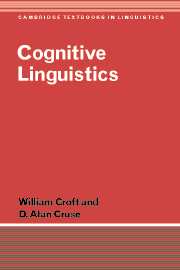Book contents
- Frontmatter
- Contents
- Figures
- Tables
- Preface
- 1 Introduction: what is cognitive linguistics?
- A conceptual approach to linguistic analysis
- Cognitive approaches to lexical semantics
- Cognitive approaches to grammatical form
- 9 From idioms to construction grammar
- 10 An overview of construction grammars
- 11 The usage-based model
- 12 Conclusion: cognitive linguistics and beyond
- References
- Index
- Index
10 - An overview of construction grammars
Published online by Cambridge University Press: 05 June 2012
- Frontmatter
- Contents
- Figures
- Tables
- Preface
- 1 Introduction: what is cognitive linguistics?
- A conceptual approach to linguistic analysis
- Cognitive approaches to lexical semantics
- Cognitive approaches to grammatical form
- 9 From idioms to construction grammar
- 10 An overview of construction grammars
- 11 The usage-based model
- 12 Conclusion: cognitive linguistics and beyond
- References
- Index
- Index
Summary
Essentials of construction grammar theories
In chapter 9, we presented the argument for representing grammatical knowledge as constructions. In this chapter, we will examine the structure of constructions and their organization in the grammatical knowledge of a speaker.
This section introduces fundamental concepts and descriptive terms for the analysis of the structure of a grammatical construction. The concepts in this section form the basis of any syntactic model, although they are combined in different ways in different syntactic theories. Any grammatical theory can be described as offering models of representation of the structure of an utterance, and models of organization of the relationship between utterance structures (presumably, in a speaker's mind). The latter are sometimes described in terms of levels of representation, linked by derivational rules. But construction grammar is a nonderivational model (like, for example, Head-driven Phrase Structure Grammar), and so a more general description of this aspect of grammatical theory is ‘organization.’
Different versions of construction grammar will be briefly outlined in §10.2. We survey four variants of construction grammar found in cognitive linguistics – Construction Grammar (in capital letters; Kay and Fillmore 1999; Kay et al. in prep.), the construction grammar of Lakoff (1987) and Goldberg (1995), Cognitive Grammar (Langacker 1987, 1991) and Radical Construction Grammar (Croft 2001) – and focus on the distinctive characteristics of each theory.
- Type
- Chapter
- Information
- Cognitive Linguistics , pp. 257 - 290Publisher: Cambridge University PressPrint publication year: 2004
- 2
- Cited by



